
Traditional parties and the 15M movement according to Aragón et al. (2013) and Toret (2013), respectively.
Network Society sociologist Manuel Castells has often in his work talked about the concept of the network enterprise. Despite he does not actually provide a formal characterization of what a network enterprise is — or I failed to find one — the concept is very appealing. And is not only appealing when confronting it with aa Taylorist/Fordist model vs. a Kanban/Toyotist model, but because it is an open enough concept (its strength, its weakness) to translate it into other contexts. For instance, politics: is there something like a network party? Are many or some of the new movements that we are witnessing — the Arab Spring, the Spanish indignados, Occupy Wall Street, YoSoy132 — actually more than movements? Are some of the evolutions of these movements — in the case of Spain, Partido X, Podemos, Guanyem — not traditional parties but… network parties?
The network enterprise
Castells, in The Rise of the Network Society, defines the network enterprise as that specific form of enterprise whose system of means is constituted by the intersection of autonomous systems of goals
. This idea of autonomy is essential as, on the one hand, it is one of the consequences of the detachment of the physical constraints once information and communications are digitized and, on the other hand, one of the main causes of the changes in institutions that we will increasingly be witnessing.
This autonomy enables a network made of firms or segments of firms, or from internal segmentation of firms
that now have the project at their core. Projects, not assembly lines, are the operational units around which all actors and resources spin. The project is an independent partnership which can be accountable for its successes and failures, which has its own structure and its own developments.
And yes, projects can interact, leading to corporate strategic alliances and inter-firm networking, but always on the basis of horizontal cooperation. Thus, we leave behind industrialism to embrace informationalism, and we leave behind mass production to embrace flexible production.
Later, in Materials for an exploratory theory of the network society, Castells emphasises that the network enterprise is not about a network of enterprises, but about internal decentralization and partnerships with other firms having as a link, as a connector the project. Through this link, information flows: sharing information is the basis of co-operation. And when the exchange of information is no more needed, the project is dismantled and alliances are over… for that project.
Although not exactly related with the network enterprise, Castells partly depicts the impact of this change in the ways of production in society. In Local and Global: Cities in the Network Societyy, the author speculates on changes to the work-living arrangements which may be coming back to prior-industrial era times, transforming industrial spaces into informational production sites, in ways similar to how craftsmen shared knowledge and expertise.
The network party
So, can we translate these reflections into the political party arena?
I believe most of the aforementioned points can be put side by side in a comparison between traditional parties and (a mostly theoretical approach to) network parties:
| Traditional party | Network party |
|
Network of (subsidiary) branches. |
Network of cells, franchises. |
|
Internal hierarchy. |
Internal independence. |
|
Internal centralization. |
Internal decentralization. |
|
Information is kept secret, even to insiders. |
Co-operation based on sharing information, especially with outsiders. |
|
The unit of production is the programme. |
The unit of production is the project. |
|
Hierachic system of procedures. |
Autonomous system of goals. |
|
Industrialism. |
Informationalism. |
|
Total planning. |
|
|
Fordism:
|
Toyotism:
|
|
Mass production. |
Flexible production. |
|
Inter-firm chain of command. |
Inter-firm networking. |
|
Corporate competition. |
Corporate strategic alliance. |
|
Vertical cooperation. |
Horizontal cooperation. |
|
Party is your life/job. |
Work-living arrangements, casual participation. |
How to more thoroughly characterize the network party, and, most important, how to identify what parties and to what degree they share these characteristics is a work that surely needs being done. Especially to test whether any of this is actually true, or if it actually works. But, at least, I believe there is some pattern that strives to match this model.
If you need to cite this article in a formal way (i.e. for bibliographical purposes) I dare suggest:
Peña-López, I. (2015) “Towards a definition of the network party” In ICTlogy,
#136, January 2015. Barcelona: ICTlogy.
Retrieved month dd, yyyy from
https://ictlogy.net/review/?p=4287
Previous post: Thesis Defence. Antonella Esposito: The Transition “from student to researcher†in the Digital Age
Next post: Open social learning: let me out, let them in
1 Comment to “Towards a definition of the network party” »
 RSS feed for comments on this post.
TrackBack URI
RSS feed for comments on this post.
TrackBack URI


Ismael, there is a pattern to match this model. I especially like the Fordism and Toyotism model. Open social innovation should be a model we strive towards.Great work, like the title.